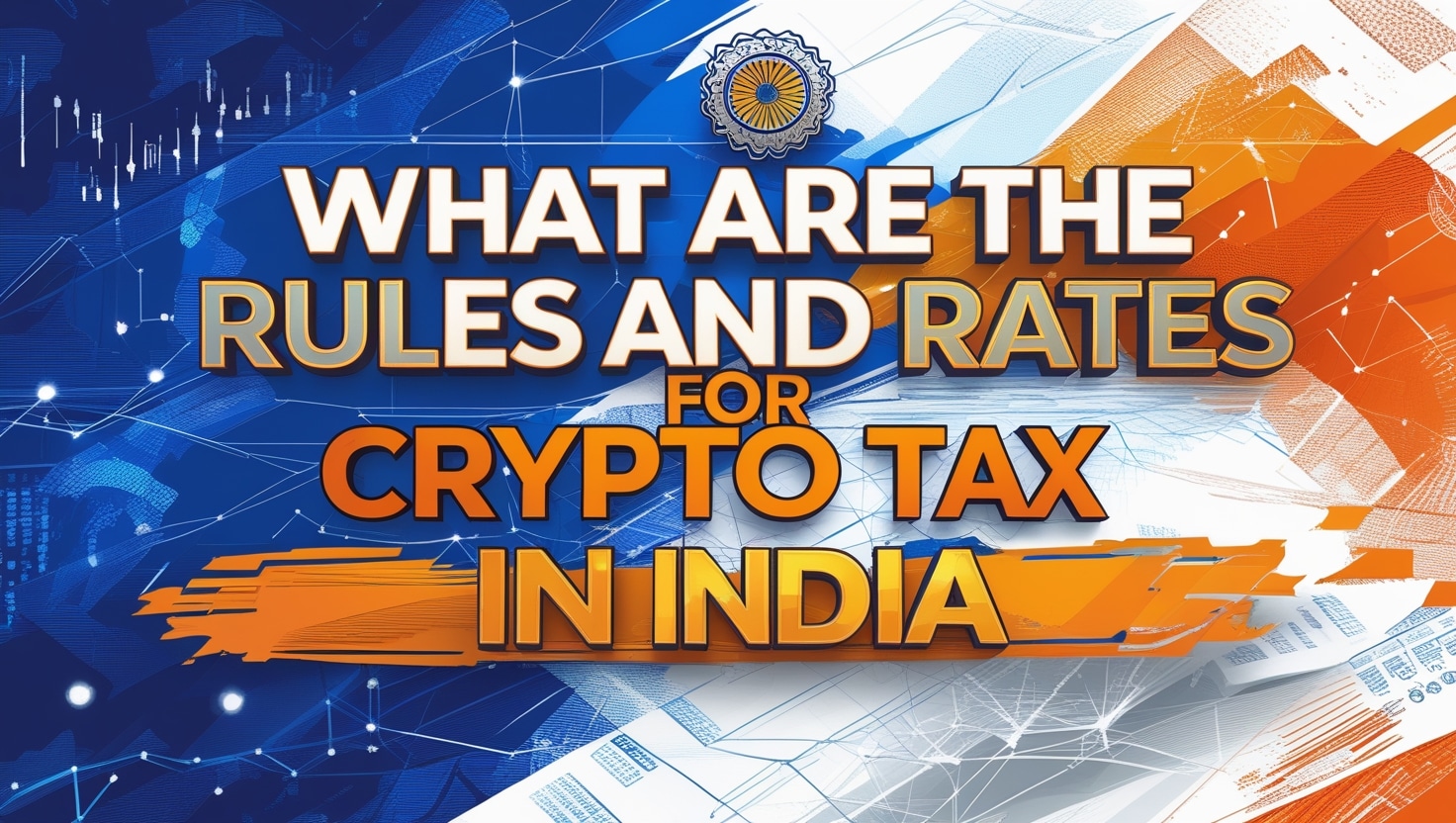
Crypto tax in India has evolved into a strict regime in the 2025–2026 financial year. The government imposes a flat tax on crypto gains, coupled with rigorous reporting and TDS requirements, making compliance essential for traders and investors. This comprehensive guide covers current tax rates on cryptocurrency transactions, rules for trading, investing, gifting, staking, and mining, the impact of Section 115BBH and 194S, treatment of NFTs and DeFi income, example tax calculations, and expert insights on compliance challenges and planning strategies.
Overview Table: What are the Rules and Rates for Crypto Tax in India?
| Tax Category | Tax Rate | Key Rules & Requirements | Important Notes |
|---|---|---|---|
| Crypto Trading/Investment Gains | 30% flat rate (+4% cess = 31.2%) |
• No distinction between short-term/long-term • Only cost of acquisition allowed as deduction • No loss offsetting allowed |
Section 115BBH applies to all Virtual Digital Assets (VDAs) • Crypto-to-crypto swaps are taxable events |
| Transaction TDS | 1% on gross amount | • Applies on transactions >₹50k annually (₹10k for others) • Deducted by exchanges or buyer • Adjustable against final tax liability |
Section 194S – applies whether profit or loss • Can be claimed as refund if no tax due |
| Staking/Mining/DeFi Rewards | Slab rate on receipt 30% on disposal |
• Taxed as “Income from Other Sources” when received • Fair market value at receipt date • Subsequent sale taxed at 30% |
Double taxation: once on receipt, once on sale • Mining costs not deductible under crypto rules |
| Crypto Gifts (Received) | Slab rate if taxable | • From relatives: Tax-free • From others: Tax-free up to ₹50k annually • Above ₹50k: Entire amount taxable |
Wedding gifts are exempt • Inheritance not taxable on receipt |
| NFTs | 30% flat rate | • Same treatment as cryptocurrencies • Classified as VDAs • Creator sales may be business income |
No special provisions for NFTs • Same TDS and reporting rules apply |
| Foreign Exchange Usage | 30% (same rates apply) | • Indian tax law applies to residents globally • TDS compliance still required • Self-reporting mandatory |
OECD CARF framework coming • Banks may block direct transfers • Risk of penalties for non-compliance |
| Compliance Requirements | Penalties: 50%-200% of tax | • Mandatory Schedule VDA reporting • Detailed transaction records required • TDS certificates and Form 26AS |
Non-compliance can lead to imprisonment • Exchanges report to tax authorities • PAN linking mandatory |
Current Crypto Tax Rates in India (2025–26)
Under Section 115BBH of the Income Tax Act, profits from the transfer of any Virtual Digital Asset (VDA) – which includes cryptocurrencies and NFTs – are taxed at a flat 30% rate. There is no distinction between short-term or long-term holdings – whether you trade and sell crypto within a week or hold it for years, the gains are taxed uniformly at 30%. Only the cost of acquisition (purchase price) can be deducted when calculating the taxable gain; no other expenses or losses are allowed as deductions. In addition, a 4% cess (health and education levy) is applied on the tax, bringing the effective rate to 31.2% for most taxpayers. Surcharges may also apply if your total income falls in higher brackets.
On top of the 30% tax, Section 194S mandates a 1% Tax Deducted at Source (TDS) on crypto transactions. Any time you sell or swap crypto, 1% of the transaction value is withheld as TDS to be deposited with the government. This TDS applies to all VDA transactions exceeding ₹10,000 in a financial year (₹50,000 for certain small investors). The primary aim of the TDS is to capture transaction details and track investments in crypto by Indian residents. Notably, TDS is collected on the gross transaction amount whether you have a profit or not – it is essentially an advance tax that can later be adjusted against your final tax liability or refunded if you incurred losses.
Crypto tax rates summary: If you make ₹1,00,000 profit from crypto trading, you owe ₹30,000 as tax (plus cess/surcharge), regardless of holding period. Meanwhile, 1% TDS is withheld on the sale amount at the time of transaction. For example, selling crypto worth ₹1,50,000 would incur a ₹1,500 TDS deduction by the exchange or buyer upfront. If you end up with no net taxable gains, that TDS can be claimed back on filing your return.
Importantly, losses from crypto cannot be used to offset gains. The law explicitly disallows setting off a loss from one crypto asset against profit from another, and you cannot carry forward crypto losses to future years. This means even if you suffered a loss on one coin, it won’t reduce the tax on profits from another coin – a rule that makes crypto trading tax-inefficient in India. “Income from crypto trading is currently taxed at 30% and will remain the same for the upcoming financial year. Further, stringent regulation prevents crypto traders from offsetting losses incurred in crypto transactions against profits from other crypto trades or any alternative income sources,” notes Kunal Vyas, Partner at Gandhi Law Associates. The absence of loss set-offs, combined with the high flat tax, has drawn criticism from investors who feel even long-term holders are treated like high-frequency gamblers under this regime.
Taxation Rules for Crypto Trading, Investing, Staking, Mining, and Gifting
Crypto trading and investing: All gains from trading or investing in cryptocurrency are taxed at the flat 30% rate in India, classified as income from transfer of a VDA. This applies when you sell crypto for INR or even when you trade one crypto for another (crypto-to-crypto swap) – such swaps are treated as a taxable event with any resultant gains taxed at 30%. There is no tax on simply buying or holding crypto (unrealized gains are not taxed), and transferring crypto between your own wallets is tax-free since there’s no change in ownership. However, spending crypto to purchase goods or services is considered a sale; any difference between the asset’s cost and its value when spent is a taxable gain. In summary, whether you are day-trading or investing for the long term, any realized profit from crypto is subject to a 30% tax in India, with no preferential rate for long-term holdings (unlike equity investments).
Crypto trading tax in India also involves compliance with TDS. If you trade on an Indian exchange, the exchange will automatically deduct the 1% TDS on your behalf and remit it to the government. If you trade on a peer-to-peer basis or on an international exchange, the responsibility to deduct and deposit the 1% TDS lies on the buyer (the person paying for the crypto). In practice, this means Indian users on foreign platforms are expected to track and pay TDS manually. The law provides a higher annual TDS threshold of ₹50,000 for “specified persons” (generally small individual investors/HUFs with no business income) and ₹10,000 for others. Beyond these amounts, every trade will incur TDS. Both buyer and seller must pay TDS in case of crypto-to-crypto trades (each on the value of the crypto they are giving up). Compliance can be cumbersome: a regular investor may need to file Form 26QE or Form 26Q to report TDS and even obtain a TAN (Tax Account Number) if not a specified person. Failing to deduct or deposit TDS can attract penalties equal to the TDS amount and even imprisonment in severe cases. In short, anyone engaging in crypto transactions should maintain detailed records and ensure TDS compliance to avoid legal trouble.
Staking and DeFi income: Earnings from staking rewards, yield farming, airdrops, or other DeFi protocols are treated as income upon receipt. Since the tax department hasn’t issued bespoke rules for these, they fall under existing provisions. Typically, any coins or tokens earned through staking or as rewards are taxed as income from other sources at your normal slab rate in the year you receive them. For example, if you stake crypto and receive 10 new tokens valued at ₹1,000 total on the day of receipt, that ₹1,000 would be added to your taxable income for that year (and taxed according to your income tax slab). Later, if you sell or exchange those rewarded tokens, 30% tax applies on any gains from that point forward. Essentially, crypto earned through Proof-of-Stake consensus or other DeFi activities can be taxed twice: first at receipt (as ordinary income on the fair market value) and again at disposal (30% on any appreciation). It’s crucial to note the distinction between the two stages: initial acquisition through DeFi is not a capital gain (since you didn’t purchase the asset), so it’s taxed at slab rates, whereas subsequent sale of those assets falls under the crypto capital gains tax.
Mining of cryptocurrency: The act of crypto mining itself (solving cryptographic puzzles to validate transactions) is not directly taxed in India. However, any crypto earned from mining is considered taxable income. According to guidance, mined coins are treated as business income for the miner. This means at the moment you successfully mine a block or receive a mining reward, you should declare the fair market value of the coins as income (taxed at your applicable income tax slab). Later, when you sell the mined cryptocurrency, you would incur a 30% tax on any capital gain – calculated from the value of the coin at the time it was mined (treated as its cost) to the sale price. For instance, if you mined 0.5 ETH when its market value was ₹50,000 (per ETH) and then sold that 0.5 ETH later when the price was ₹80,000, the mining gave you ₹25,000 income (taxed at slab) and the sale yielded a ₹15,000 capital gain that is taxed at 30%. Mining often involves significant costs (hardware, electricity), but unfortunately those expenses cannot be deducted under the crypto tax provisions (only the cost of acquisition – which for a miner is essentially zero or the coin’s value at reward time – is considered). Miners should maintain thorough records of the dates and values of mined coins to accurately report income and future gains.
Gifting crypto assets: Gifting cryptocurrency or NFTs is allowed, but it triggers tax implications for the recipient. Crypto gifts are taxed in the hands of the receiver as income from other sources, unless specifically exempt. If you receive a crypto gift from a close relative (e.g. parents, spouse, siblings) or on occasions like your marriage, it is fully tax-exempt. Also, a total value of gifts up to ₹50,000 in a financial year from non-relatives is exempt – if you exceed this threshold even by ₹1, the entire amount becomes taxable. For any taxable crypto gift, the fair market value on the date of receipt is added to the recipient’s income. It will be taxed at the recipient’s applicable slab rate (not at the flat 30%, since this is not a gain from transfer by the recipient). For example, if a friend sends you crypto worth ₹60,000 as a gift, you must report ₹60,000 as other income (since it exceeds ₹50k and is from a non-relative). Assuming you fall in the 30% tax bracket, you’d pay about ₹18,000 tax on that. If the gift was only ₹40,000 or came from your sibling, no tax would apply on receipt. However, if and when you sell the gifted crypto later, any gain over the value at which you received it will be taxed at 30% as your capital gain. One important point for gifted assets: the cost basis for calculating the gain on sale is the original purchase price that the giver paid. The holding period of the giver may also be added to determine if it would have been long-term or short-term, though as noted, crypto gains don’t receive any long-term tax benefit in the current regime. Bottom line – gifts of crypto in India need careful tracking, and recipients should be aware of potential tax liabilities. When gifting, it’s wise to keep it within family or under ₹50k if you want to avoid triggering a tax event.
Impact of Section 115BBH and 194S on Crypto Taxation
The introduction of Section 115BBH (from April 1, 2022) and Section 194S (from July 1, 2022) reshaped crypto taxation in India. Section 115BBH, in particular, put crypto assets in a category akin to lottery winnings or gambling income, removing any advantages of treating them like capital assets. Under this section, crypto profits are taxed at 30% flat, with no exemptions or indexation, irrespective of holding period. It explicitly bars investors from claiming typical deductions (like trading fees, interest costs) and prohibits loss offsetting across transactions. This harsh provision means a trader who made ₹1 lakh profit on one coin and ₹1 lakh loss on another in the same year would still have to pay ₹30,000 tax on the profit and get no credit for the loss, effectively taxing away the gains while the losses “die” unused. “No relief for losses or deductions” is a cornerstone of the regime, as losses from one VDA cannot offset gains from any other income or even other VDA trades. The policy rationale was to simplify tax administration and deter speculative high-volume trading, but it significantly increased the effective tax burden on crypto market participants.
Section 194S has had an equally far-reaching impact on the crypto ecosystem. The 1% TDS on every crypto transaction above the small annual threshold might seem minor, but it introduced friction in liquidity. Traders see 1% of their capital locked up on each trade (refundable later if they have no net tax due, but in the interim, it’s out of circulation). Over the course of many trades, this adds up and can erode trading capital. Volumes on Indian exchanges plunged after 194S came into effect, as many active traders either drastically reduced their trading frequency or moved to foreign exchanges to avoid the TDS drag. In fact, studies show trading volumes on Indian crypto exchanges dropped by 97% between Feb 2022 and Jan 2024, and active users fell by 81%, largely attributed to the TDS and tax rules. The intent to track transactions is being achieved, but at the cost of market participation. “India’s 1% TDS and 30% tax on VDAs led to a 97% trading volume drop, 81% user decline, and migration to offshore exchanges,” according to a report by researchers at NALSAR University and a tax partner at Trilegal. This capital flight defeats some of the purpose of the law, which was to increase tax revenue – if trades move offshore, the government neither sees the transactions easily nor collects much TDS (and eventual tax if profits aren’t reported).
From a compliance standpoint, Sections 115BBH and 194S have introduced heavy reporting obligations. Crypto gains now must be declared in a dedicated schedule (Schedule VDA) when filing income tax returns. Starting FY 2025-26, it’s mandatory to use Schedule VDA to report all crypto transactions with details like date, value, and cost for each trade. This granular reporting requirement forces investors to keep thorough records of every trade. Tax authorities are strictly enforcing compliance, cross-verifying TDS reports, exchange data, and annual statements to flag any discrepancy. The Central Board of Direct Taxes (CBDT) has also begun seeking feedback on these policies, acknowledging issues like trade migration and the inability to offset losses. In August 2025, the CBDT queried industry stakeholders on whether the 1% TDS should be adjusted and if loss set-off might be permitted in the future, among other regulatory questions. This hints at potential tweaks to make the framework more practicable. But until any changes are enacted, crypto investors must navigate the existing rules where every rupee of gain is taxed at 30%, every trade is tracked via TDS, and any misstep in compliance can attract steep penalties (for instance, failing to deduct/pay TDS can lead to a penalty equal to the TDS amount and even jail up to 7 years).
In summary, Section 115BBH solidified the tax on cryptocurrency in India as one of the highest and strictest in the world, and Section 194S enforced transaction-level visibility. Together, they’ve significantly increased the tax liability on crypto activities and introduced new challenges. As Aaron Kamath, leader in Nishith Desai Associates’ tech law practice, observes, the government is “obligating reporting entities dealing with crypto-asset transactions to furnish details to the income tax authorities… [and] giving the Government power to issue rules for entities to register with tax authorities and conduct due diligence to identify crypto users”, signaling a clear intent to leave no crypto transaction untracked. Investors in 2025–26 must therefore approach crypto with full awareness that the taxman is monitoring closely, and both the profits and the processes (reporting/TDS) are under stringent oversight.
Tax Treatment of NFTs, DeFi Protocols, and Foreign Exchange Usage
Non-Fungible Tokens (NFTs): Under Indian law, NFTs are explicitly classified as virtual digital assets and taxed in the same manner as cryptocurrencies. If you create or purchase an NFT and later sell it for a profit, that profit is subject to the flat 30% tax (plus surcharge and cess) just like any crypto coin gain. For example, imagine you bought an NFT artwork for ₹10,000 and sold it for ₹50,000; your ₹40,000 profit would attract a ₹12,000 tax. If you gift an NFT, the gift tax rules discussed earlier apply (receiver pays tax if applicable). One nuance with NFTs: if you are the original creator selling your NFT, the proceeds might be considered business income (especially if creating art is your business). However, in absence of special provisions, even creators are generally falling under 115BBH on the sale of their NFTs. Practically, this means creators cannot deduct creation expenses, and the income is taxed at 30%. For secondary sales of NFTs (reselling collectibles, etc.), it’s straightforward VDA taxation. GST might also apply on NFT platform fees or sales in certain cases (if viewed as supply of digital goods/services), but GST law on crypto is still evolving. Notably, the government expanded the definition of VDAs in Budget 2025 to ensure any crypto-asset based on distributed ledger technology, including NFTs, is covered – closing any ambiguity. The key takeaway for NFT enthusiasts is that tax on cryptocurrency in India doesn’t spare digital collectibles: any income from NFTs – primary sale, resale, or gifting – can lead to tax events.
DeFi and crypto lending/borrowing: Decentralized Finance (DeFi) activities, like lending crypto for interest, borrowing, yield farming, liquidity mining, etc., fall into a gray area with no direct law yet, but the tax treatment can be inferred from general principles. Income earned via DeFi protocols is typically taxed at the time of receipt, as it effectively behaves like interest or rewards. For instance, if you use a DeFi platform and earn 100 governance tokens as yield, the value of those tokens on the day you received them is taxable income (just as staking rewards are. This would be added to your “other income” (or business income, if you’re doing it professionally) and taxed at your slab rate. Later on, if you dispose of those tokens or any assets you acquired through DeFi, the standard 30% tax on any profit applies. One complexity in DeFi is valuation – you must use the fair market INR value at receipt. Another is tracking – DeFi often involves many micro-transactions (auto-compounding yields, etc.) which can complicate record-keeping. Despite the lack of official guidance, conservative practice is to treat all DeFi earnings as taxable. So if you participated in yield farming and received crypto rewards worth ₹20,000 over the year, you should report that ₹20,000 as income. If you simply move crypto into a liquidity pool or smart contract and later withdraw it without having “earned” new tokens (besides maybe some fee rebate), that might not be a taxable event by itself – only the new income or subsequent gains are taxed. Also note that certain DeFi events like hard forks or airdrops (which often accompany DeFi ecosystems) are treated like gifts: the new coins from a fork or an airdrop are taxed at receipt (slab rate) and on sale (30% on gains). The bottom line is, even though DeFi operates in a decentralized manner, Indian residents are expected to self-report and pay taxes on any income or gains derived from these protocols. Skipping this is risky – with increased global information sharing, even decentralized transactions might come under scrutiny if you later convert those assets to fiat or identifiable assets.
Using international exchanges and foreign crypto platforms: Many Indian crypto users turned to offshore exchanges (like Binance, Bybit) and decentralized exchanges (DEXs) in an attempt to bypass the 1% TDS and trade freely. It’s important to stress that Indian tax law applies to residents on their worldwide income – so profits you make on a foreign exchange are still taxable in India. There is no loophole that exempts foreign-held crypto from Indian tax as long as you are an Indian tax resident. Thus, you are required to declare those gains in your income tax return and pay the 30% tax, just as you would for trades on an Indian platform. Moreover, the obligation to comply with TDS technically still exists. If you as an Indian resident buy crypto from someone (even via an international exchange), you are supposed to deduct 1% of the payment as TDS if the annual threshold is crossed. In practice, this is very hard to enforce – exchanges outside India do not facilitate TDS, and peer-to-peer trades on forums obviously don’t either. But legally, the buyer in such cases bears the onus of TDS compliance. Non-compliance can be discovered if, for example, you later bring that money into India or the tax department scrutinizes your crypto holdings through other data.
It’s worth noting that regulatory bodies like RBI have also been wary of overseas platforms. Banks in India often block direct transfers to foreign crypto exchanges due to RBI/FEMA (Foreign Exchange Management Act) concerns. Officially, using foreign exchanges lies in a gray zone – crypto is not banned, but sending money abroad to buy crypto might be seen as violating foreign exchange rules if not done under the Liberalized Remittance Scheme (LRS). Still, many users circumvent this via peer transfers or third-party payment channels. Tax-wise, if you do use an offshore exchange or DEX, you must self-report gains. Authorities are ramping up capabilities to trace such assets. India is one of the jurisdictions adopting the OECD’s Crypto-Asset Reporting Framework (CARF) for automatic exchange of information. Under CARF, foreign exchanges and custodians may be required to share details of crypto holdings and transactions of Indian clients with the Indian government. This means that in coming years, your offshore crypto wallet might not be as hidden as you assume. “India is expected to adopt OECD’s Crypto-Asset Reporting Framework, which may require foreign exchanges to report Indian users’ crypto holdings,” notes a Cointelegraph report. Additionally, Budget 2025 introduced new provisions (Section 285BAA) compelling any entities involved in crypto (including possibly foreign entities operating in India’s realm) to register and report transactions.
In essence, while using international platforms might offer a smoother trading experience (no immediate TDS cutting liquidity), your tax obligations remain unchanged. All profits are taxable, and you’re expected to follow the same rules of computation and reporting. If anything, compliance is trickier because you must manually track and deposit any TDS if applicable. Ignoring these obligations could result in penalties later if the Income Tax Department uncovers your unreported crypto assets (unreported foreign assets can even attract severe penalties under anti-black money laws). The safer approach is to trade transparently and keep documentation of any offshore transactions. As Purushottam Anand, advocate and founder of Crypto Legal, emphasizes, India is likely moving toward a comprehensive regulation instead of a ban, in alignment with global consensus – meaning better legal clarity is coming, but also stronger oversight. “Considering the G20… it is likely that the government will introduce a comprehensive VDA regulation. India has consistently emphasised that regulation or banning can be effective only with significant international collaboration,” Anand noted. So, the era of shadow trading on foreign exchanges may be short-lived – compliance will eventually catch up globally.
Example Tax Calculations for Crypto Gains and Gifts
To solidify the understanding of crypto tax India rules, let’s go through a few example scenarios:
- Example 1: Short-term vs long-term holding (no difference in tax) – Rahul bought crypto for ₹100,000 and sold it for ₹150,000 a few months later, making a profit of ₹50,000. Whether Rahul held this crypto for 3 months or 3 years, his tax on the ₹50,000 gain is 30%. He would owe ₹15,000 as tax (plus cess) to the government. There is no lower tax rate for long-term holding. By contrast, if this were a stock investment held over a year, he might pay only 10% as LTCG tax – but for crypto, India doesn’t offer such breaks. Now, suppose Rahul also had a second crypto trade where he lost ₹20,000. Under 115BBH, he cannot subtract that loss from his ₹50k profit. He will still pay tax on ₹50k in full (₹15k), and the ₹20k loss is disregarded (not offsettable, not carry-forwardable). This results in a much higher effective tax on net profits. Tax tip: Plan for a 30% cut on any profitable trade and remember that losing trades won’t reduce that bill – this should encourage cautious trading or hedging strategies where possible.
- Example 2: Crypto-to-crypto trade – Meera swaps 1 Ether for 0.03 Bitcoin on an international exchange. At the time of trade, the value of 1 ETH is ₹1,50,000 and 0.03 BTC is ₹1,52,000 (assume roughly equal, slight slippage). For tax purposes, Meera is effectively “selling” her ETH for ₹1.5 lakh and buying BTC. If she had originally acquired that 1 ETH for ₹1,00,000, she now realized a ₹50,000 capital gain on disposing of it. She owes ₹15,000 tax (30% of ₹50k). Additionally, since this is a crypto-to-crypto transaction, TDS at 1% applies on both sides. Meera, as the buyer of BTC, should deduct 1% of ₹1,52,000 (₹1,520) as TDS to the government, and as a seller of ETH, 1% of ₹1,50,000 (₹1,500) would be deducted by the counterparty. In practice, on an exchange platform, Meera might not see this happen explicitly, but she should be aware of these obligations. Net result: Meera ends up with 0.03 BTC (worth ₹1.52 lakh), a tax liability of ₹15k, and around ₹1.5k cut as TDS (which she can claim back or adjust in her tax filing).
- Example 3: Gifting scenario – Anand gifts his friend Varun a Bitcoin worth ₹60,000. Since Varun is not a relative and the value exceeds ₹50k, the entire ₹60,000 is taxable for Varun as income from other sources. Let’s say Varun is in the 20% tax slab; he would have to pay around ₹12,000 tax on this gift (20% of ₹60k, ignoring cess for simplicity). Now Varun holds this Bitcoin (or fraction of BTC). The cost basis for Varun is deemed to be the same as it was for Anand (original owner). Suppose Anand had bought that BTC for ₹40,000 originally. If Varun later sells it for, say, ₹70,000, the capital gain for Varun would be computed as sale ₹70k minus original cost ₹40k = ₹30,000 gain. Varun will pay 30% on this ₹30k gain = ₹9,000 tax, irrespective of the fact that he already paid tax when he received the gift. (The gift tax and the gain tax are two separate events.) If instead the crypto’s value went down and Varun sold at ₹30,000 (a loss relative to original ₹40k cost), he would have a ₹10,000 capital loss – unfortunately, that loss cannot offset any other income, though Varun wouldn’t owe gain tax. Key point: gifts from immediate family (say Anand was Varun’s brother) would be tax-free on receipt, and gifts of smaller amounts under ₹50k cumulative per year from friends are also tax-free. So if Anand had gifted only ₹45,000 worth of crypto, Varun wouldn’t pay tax on receiving it. It pays (literally) to be mindful of these thresholds when gifting crypto.
These examples illustrate that crypto taxation in India is unforgiving: flat 30% on gains regardless of context, and careful record-keeping is needed to handle scenarios like gifts or coin swaps. Always calculate the cost of acquisition and sale value in INR for every transaction to determine your taxable gain or income.
Expert Insights on Compliance Challenges and Tax Planning
Compliance challenges: The current crypto tax framework in India poses significant compliance burdens. One major challenge is the detailed reporting now required. Every transaction must be reported in the Income Tax Return’s Schedule VDA, which means maintaining a ledger of all crypto buys, sells, swaps, receipts, and payments. For active traders dealing in hundreds of transactions, this can be daunting. Exchanges are now obligated to assist in this reporting. “Budget 2025 has inserted new section 285BAA mandating reporting entities dealing in crypto-assets to furnish information on transactions… similar to the reporting obligations imposed on mutual fund companies and stock exchanges,” explains Kunal Vyas. In practice, this means Indian crypto exchanges must report user transactions to the tax department, so your trading data is being directly shared with authorities. The government has also broadened the definition of VDAs to ensure no digital asset slips through. Know-Your-Customer (KYC) norms and PAN linking with exchange accounts ensure that tax officials can match crypto transactions to individual taxpayers via the Annual Information Statement (AIS).
Another challenge is TDS compliance for peer-to-peer and overseas trades. As discussed, if you’re not on an Indian exchange, you are expected to deduct and deposit TDS yourself. This involves filing forms within tight deadlines, obtaining a TAN for some, and understanding the procedure – tasks that typical retail investors are not familiar with. The government’s aggressive stance is evident from new penalties for TDS evasion introduced in 2023 – a 100% penalty on the TDS amount not deducted/deposited, plus interest, and potential prosecution. This has understandably made many investors nervous. The Income Tax Department has reportedly sent tens of thousands of compliance notices to crypto investors for discrepancies and non-reporting in the past year.
Additionally, the inability to offset losses is not just a financial drawback but a compliance headache – it means you might owe taxes even if your overall portfolio lost money, which many find counter-intuitive and burdensome. Record-keeping is also complicated by the nature of crypto: you must convert every transaction value to INR at that exact time, which requires historical price data and consistency in methodology. Using portfolio trackers or crypto tax software (like Koinly, CoinTracker, etc.) becomes almost necessary to generate accurate reports.
Experts point out that the heavy tax and TDS have had unintended consequences. “This [tax policy] makes us feel like it’s less of a tax law and more like daylight robbery… even a prudent, long-term investor is treated like a high-frequency gambler. No tax efficiency, no loss planning, and no differentiation between long-term holding,” writes Srinivas, a crypto tax expert, highlighting the community’s frustration. The draconian provisions have prompted many Indian crypto startups and high-volume traders to relocate to more friendly jurisdictions (Dubai, for example, has emerged as a crypto hub for Indians) – leading to a brain drain and potential loss of innovation in the Web3 space, which is a compliance cost for the country in a broader sense. The tax on cryptocurrency in India is among the highest in the world; by comparison, the US treats crypto as capital assets with lower long-term rates, and some countries have zero crypto tax. The industry is lobbying for moderation. In a detailed study, NALSAR University and crypto experts recommended slashing TDS to 0.01%, allowing loss offsets, and reducing the 30% rate to a more reasonable level. It remains to be seen if the government will heed these suggestions.
Planning strategies: Given the rigid rules, what can Indian crypto investors do to legally optimize their tax situation? Here are a few insights and strategies from experts:
- Limit high-frequency trading: Each trade triggers 1% TDS and potentially a taxable event. Casual investors may opt to HODL (hold) longer or rebalance less frequently to minimize TDS outflow and simplify reporting. Since there’s no benefit to holding beyond a year (tax-wise), the decision to hold should be based on market view rather than tax. But trading less often means fewer instances of 1% TDS being cut and fewer line items to report on the tax return. Some exchanges have introduced derivative products (futures, options) on crypto that may not directly fall under 194S (thus avoiding TDS on each contract turnover). However, derivatives come with their own complexity and risk, and any gains are still taxable.
- Use crypto-specific tax tools: To ease compliance, investors can use software or services that aggregate all transactions across exchanges and wallets, calculate gains, and even fill out the Schedule VDA. Several India-based platforms (such as KoinX, Zerion for reporting, etc.) and international ones (Koinly, CoinTracker) support Indian tax rules. These tools can also generate tax-loss harvesting reports – although you cannot offset crypto losses against gains, you might use them against crypto gains if the law changes in the future, or simply keep a record for your own reference of how much capital got wiped out due to the no-offset rule (information that could be provided to policymakers as feedback).
- Explore regulated investment routes: Interestingly, some experts have pointed out that investing in crypto via certain indirect means can be more tax-efficient. For example, as The Economic Times reports, Bitcoin Exchange-Traded Funds (ETFs) or similar products listed in other jurisdictions can offer better tax treatment. If an Indian invests in a foreign Bitcoin ETF (say in the US or under the LRS), the gains might be taxed as capital gains on foreign assets – potentially 20% with indexation if held long enough, or even 10% without indexation if it qualifies as a non-equity mutual fund. The ET article noted Bitcoin ETFs could be taxed at an effective ~12.5% for long-term holdings versus 30% on direct Bitcoin. This requires sophisticated planning (and comes with risks like currency risk and differences in regulations), but it’s a thought for HNIs or serious investors. Another route could be GIFT City in India’s IFSC, where some crypto derivative products might be offered under different tax rules – though this is nascent.
- Family gifting and inheritance: As discussed, crypto gifts to close family are tax-free. This opens some estate planning opportunities. An investor sitting on large crypto gains might consider gifting some crypto to family members who are in lower tax brackets or who need it – the gift itself (if to defined relatives) has no tax, and then that family member can sell in a year where perhaps their slab rate is low, thereby potentially paying less than 30% (remember, the 30% rate is specifically under VDA rules, but if one classifies it under capital gains or if the relative’s total income is small, there is some interpretational grey area – the safest view is still 30% flat, but some have pondered if a person’s slab could apply if crypto is deemed capital gains for them with total income below the threshold. However, ITD’s stance is 30% irrespective of individual slab except for those special incomes like gifts on receipt). At the very least, gifting crypto to your spouse or children could spread out the holdings so that future gains are realized by them (though clubbing provisions might apply for spouse/minor children, so caution and a CA’s advice is needed). Also, inheriting crypto (passing it on via will) currently is not a taxable event at the time of inheritance (inheritance is not considered a transfer for tax), and the heir would pay tax only when they sell, taking the original owner’s cost as basis. This is similar to other assets and could be a factor in long-term planning.
- Maintain strict documentation: Experts universally advise keeping detailed records of all crypto activity. This includes exchange account statements, screenshots of trades (with INR values), records of peer-to-peer deals, and any TDS paid. Given the scrutiny, if you ever face a tax audit or notice, having a proper paper trail will save you from panic. “Ensure compliance and greater tax transparency,” as the government put it. If you’ve transacted on foreign platforms, consider voluntarily filing the related information (perhaps under the foreign asset schedule if applicable) to stay clean.
- Stay updated on rule changes: The crypto tax landscape is still evolving. The government’s request for industry input in 2025 suggests tweaks might occur – such as a reduction of TDS or rules for loss offset in certain cases. Any such change could alter strategies (e.g., if loss offset gets allowed, aggressive trading could become slightly more viable). Also, international developments like the global minimum tax standards for crypto transactions under CARF could impact compliance requirements. Following credible crypto tax experts (many CAs are active on social media decoding new rules) or consulting a tax advisor each year before filing returns is wise.
In the words of Aaron Kamath, “the Finance Bill, 2025 seeks to clamp down on undisclosed transactions…obligating reporting entities… to conduct due diligence to identify crypto users or owners”. The government’s clear message is to play by the rules. By planning your trades thoughtfully and keeping transparent records, you can participate in crypto while staying on the right side of the law. The heavy taxes do cut into returns, but on the flip side, paying your crypto taxes converts what was once a legal gray asset into a fully compliant asset class in your portfolio – giving you peace of mind and security to continue investing and building in this sector.
Conclusion: Navigating Crypto Tax in India in 2025–26
The crypto tax in India for FY 2025–26 remains a stringent regime that all crypto users must carefully navigate. A flat 30% tax on gains, 1% TDS on transactions, and extensive reporting requirements mean that compliance is now as important as trading strategy. As a crypto investor or trader in India, you should factor in taxes from the moment you plan a trade – for instance, setting aside roughly one-third of any profits for taxes and accounting for TDS affecting your capital liquidity. Make use of the Schedule VDA in the ITR to report your crypto incomes and ensure you meet the filing deadlines (usually July 31 following the financial year, unless extended). Non-reporting is not an option; the tax authorities have multiple data streams to catch undeclared crypto gains, and penalties can be severe (up to 200% of tax due, plus interest, and even jail in worst cases of willful evasion).
On a practical level, always remember these guidelines:
- Keep records of every crypto transaction in INR terms. Many exchanges provide monthly statements – save them. For peer trades, note the date, value, and counterparty details.
- Stay TDS compliant. If using Indian platforms, verify that TDS is being deducted. If not (e.g., on decentralized platforms), consult a tax expert on how to remit the TDS. The government has made TDS compliance a top enforcement priority, so don’t ignore it.
- Plan for taxes in your cash flow. Since TDS takes 1% off every trade, heavy traders might need to allocate additional funds to maintain trading volume. Also, if you have a big profit year, arrange liquidity to pay the 30% tax by advance tax installments or before filing, to avoid interest on late payment.
- Use expert resources. The crypto tax domain is new and complex – leverage software, guides (like this one), and professional advice. Many tax experts in India (CAs) are now well-versed in crypto; engaging one can help in optimizing your tax position and ensuring you don’t make a filing mistake.
- Stay informed on policy changes. Crypto taxation and regulation in India is in flux, with potential revisions in upcoming budgets. Being aware can help you adjust strategies (for example, if TDS is relaxed or if certain crypto classifications change).
While the current taxes do reduce net returns on crypto investments, they also underscore the legitimacy of the asset class – the government is effectively acknowledging crypto through taxation. With proper planning and compliance, you can still participate in the crypto market and benefit from its opportunities. Navigating crypto taxes is now an integral part of crypto investing in India. By understanding the rules and following the best practices outlined above, you can trade or invest with confidence, knowing that you won’t have unwelcome surprises from the taxman down the line. As the famous saying goes, “Nothing is certain except death and taxes.” In the crypto world, taxes have certainly arrived – so approach them with the same diligence as you do your investments.
FAQ
What is the tax rule on crypto in India?
All profits from cryptocurrency trading or spending are taxed at a flat 30% rate in India. This falls under Section 115BBH of the Income Tax Act. In addition, a 1% TDS is levied on each crypto transaction (on the gross amount) if your total trades exceed ₹50,000 in a year (₹10,000 for non-specified individuals). The 1% TDS is usually handled by exchanges for domestic trades, but in peer-to-peer or foreign trades, the buyer must deduct it. There is also a 4% cess on the tax amount. No other deductions (other than cost of acquisition) are allowed against crypto income, and you cannot offset crypto losses against any gains.
How do I report cryptocurrency in my Income Tax Return (ITR)?
Starting with FY 2023-24, the ITR forms have a dedicated Schedule VDA to report crypto transactions. You should declare all your crypto trading profits, losses (even though not deductible), gifts received, staking or mining income, etc., in this schedule. For most individuals who treat crypto as investment, this will go in ITR-2 under capital gains (or in a separate VDA schedule within it). If you are doing extensive trading as a business, you might use ITR-3. In the Schedule VDA, you’ll provide details such as sale proceeds, cost of acquisition, date of acquisition and transfer, and TDS paid. Ensure you also report any crypto gifts received under “Income from Other Sources” if applicable. Essentially, every taxable crypto event should find a place in your tax return. It’s wise to use the information from your exchange statements or crypto tax software to fill this accurately. Once reported, the income gets taxed at the applicable 30% rate in the tax calculation.
Do I have to pay tax if I haven’t sold my crypto?
No, you don’t pay any tax for simply holding crypto. Tax is triggered only when there is a “transfer” of the asset – such as selling it for fiat, trading it for another crypto, or using it to buy something. Unrealized gains (price increase of coins you still hold) are not taxed in India. Also, moving crypto between your own wallets or accounts is not considered a transfer and has no tax implications. However, if you received free crypto through means like airdrops, staking rewards, or mining, those are taxed in the year of receipt even if you haven’t sold them (they are considered income on receipt). But mere market gain in your portfolio isn’t taxable until you actualize it by selling or spending the crypto.
What happens if I don’t pay or report my crypto taxes?
Failing to report crypto income or pay the due tax is a violation of tax law and can lead to serious consequences. The Income Tax Department is actively tracking crypto transactions through exchanges and TDS reports. If you under-report or omit your crypto gains, you can face penalties of 50% to 200% of the tax evaded. For example, if you owed ₹1,00,000 in crypto tax and didn’t pay, the penalty alone could be ₹50k to ₹2 lakh, on top of the tax and interest. In severe or willful cases, especially if large sums are involved, it can even lead to prosecution with imprisonment up to 3–7 years. Recently, tax authorities have issued tens of thousands of notices to individuals who traded crypto but didn’t mention it in their returns. It’s also worth noting that crypto exchanges in India are furnishing transaction data to the government, so it’s increasingly easy for them to spot discrepancies. In short, the risk isn’t worth it – always declare and pay the tax to avoid legal trouble.
Is transferring crypto between exchanges or wallets subject to the 1% TDS?
No. Merely transferring your own crypto between wallets or exchange accounts (for instance, from one exchange to another, or from exchange to your private wallet) is not considered a “transfer” for tax purposes. Since you are not changing ownership – it’s still your asset – no TDS is applicable and it’s not a taxable event. Section 194S’s TDS applies only on transactions that are sale/transfer in nature (change of ownership). However, be careful: if you transfer crypto to another person’s wallet (even as a gift), that’s not a sale for you but could be a taxable gift for them. But purely moving your crypto around your own addresses incurs no 1% TDS and no 30% tax. Many exchanges mark such internal transfers differently; some might even show a notional value but they do not deduct TDS on withdrawals or internal transfers.
Who is responsible for deducting the 1% TDS on crypto trades?
If you trade on an Indian regulated crypto exchange, the exchange will automatically deduct the 1% TDS on your sell transactions (or equivalent) and deposit it to the government. They also usually provide a TDS certificate or report so you know how much was deducted (you can see it in Form 26AS/Annual Information Statement as well). If you are using a peer-to-peer platform or an international exchange, the obligation shifts to the buyer (the person paying INR or giving the asset of value) to deduct 1% TDS from the payment. For example, if you sold crypto to someone on a P2P deal, that buyer should cut 1% of the price and give it to the government, only paying you 99%. In practice, this means you as an Indian seller should insist on that or you might be held liable if TDS isn’t done. Similarly, if you are the buyer on P2P, it’s your job to deduct TDS from what you pay the seller. In crypto-to-crypto trades, both parties are technically buyers of one asset and sellers of another, so both have to deduct TDS on the amount they are paying with – this gets tricky, which is why most people stick to exchanges or platforms that handle it. If TDS was not deducted in a transaction where it should have been, you might need to later pay it and potentially face a penalty, so ensure at least one side of the trade (preferably the platform or the buyer) covers the TDS.
Are crypto gifts or inherited crypto taxable?
Receiving a crypto gift from someone other than specified relatives can be taxable. If the total value of crypto gifts from non-relatives exceeds ₹50,000 in a financial year, then the entire value of those gifts is treated as income for you. For example, if friends gifted you crypto worth ₹60k, you’d have to pay tax (at your slab rate) on ₹60k. Gifts from close relatives (like parents, siblings, spouse, children, etc.) are fully exempt – you could receive ₹10 lakh of Bitcoin from your brother and owe no tax on receipt. Also, any crypto received as a wedding gift or through inheritance is not taxed as income (wedding gifts are exempt, inheritance is not considered income). If you gift crypto to someone, that is not a taxable event for you (it’s not a sale), but if the recipient is not your relative, they might have to pay tax on it as explained. For inheritance, when you eventually sell inherited crypto, you’ll pay the 30% tax on any gains relative to the original owner’s purchase price (stepped up by indexation isn’t given since crypto is not getting that benefit, but holding period of the previous owner can be counted to determine if it was long-term – though again, no tax difference in rate). In summary: crypto gifts received can be tax-free if from family or under ₹50k, otherwise taxable; gifted or inherited crypto when sold will be taxed like any other crypto based on gains.
How much is the crypto tax rate in India and is there any way to reduce it?
The crypto tax rate in India is a flat 30% on any gains. This rate is fixed, regardless of your income level or holding period of the asset. On top of that, a 1% TDS on transactions is in effect (which is an advance tax that can be adjusted). There are also surcharges for high-income individuals (if total income crosses ₹50 lakh, ₹1 crore, etc., surcharge of 10%, 15%, etc. applies on tax) and the 4% cess on the final tax. In effect, for large investors, the tax can be slightly above 30%. There is no way to get a lower tax rate on crypto under current laws – even if your overall income is within the 5% slab, your crypto gains are still taxed at 30%. Deductions like 80C, 80D cannot be claimed against crypto income; and you can’t set off crypto losses to reduce the taxable amount. The only “reduction” comes from ensuring you claim credit for the 1% TDS – meaning the TDS subtracted can be subtracted from your final tax payable (or refunded if it exceeds your tax). Some investors seek to legally mitigate tax by structuring investments through entities or moving to places with no crypto tax, but for an Indian resident individual, there isn’t a provision to pay less than 30% on crypto profits. Always be cautious of any schemes that claim to avoid the tax – unless the law changes, the rate is uniform. The best you can do is plan your trades and other income such that you’re compliant and perhaps invest through avenues like GIFT City or foreign ETFs which might indirectly offer better tax treatment (but those come with their own regulations and are not mainstream yet).

















